Off the Cartesian Grid
Oral
Acquisition, Reconstruction & Analysis
Wednesday, 20 June 2018
| S05 |
16:15 - 18:15 |
Moderators: Corey Baron, Maria Altbach |
16:15
 |
0933.
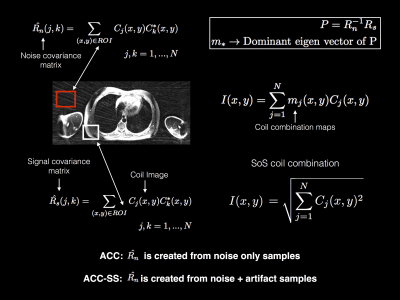 |
 Radial streaking artifact reduction using phased array beamforming Radial streaking artifact reduction using phased array beamforming
Sagar Mandava, Mahesh Keerthivasan, Diego Martin, Maria Altbach, Ali Bilgin
Streaking artifacts can occur in radial MR imaging especially in applications that require large FOVs. In abdomen MRI, the common sources of streaking are unsuppressed fat and the arms with the latter being a particularly problematic source of streaking. The standard approach to mitigate streaking is to identify, either manually or automatically, the subset of coils that are heavily contaminated by streaking artifacts and discard them prior to coil-combination. We present a simple approach to mitigate streaking artifacts that leverages phased array beamforming (spatial filtering) and demonstrate its performance on radial fast spin echo data.
|
16:27
|
0934.
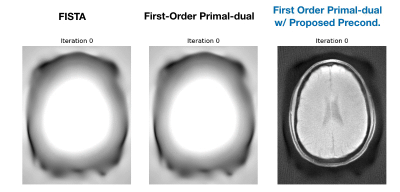 |
 k-space Diagonal Preconditioner: Speeding Up Iterative Reconstruction For Variable Density Sampled Acquisitions Without Compromises k-space Diagonal Preconditioner: Speeding Up Iterative Reconstruction For Variable Density Sampled Acquisitions Without Compromises
Frank Ong, Martin Uecker, Michael Lustig
Variable density sampling is now commonly used in advanced imaging methods. However, due to ill conditioning, reconstruction can take hundreds of iterations, limiting its clinical application. One effective heuristic to accelerate convergence is the use of density compensation, but it is known to increase reconstruction error. An alternative is to use preconditioners, but existing preconditioners increase computation by performing additional image convolutions. Our goal here is to accelerate iterative reconstruction convergence without compromises. We propose a k-space diagonal preconditioner, without compromising reconstruction error, or computation. We demonstrate on datasets that reconstructions with the proposed preconditioner converge at around 10 iterations.
|
16:39
|
0935.
 |
 Accelerated Spiral imaging for Real-time Cardiac MRI Accelerated Spiral imaging for Real-time Cardiac MRI
Zhixing Wang, Xue Feng, Quan Dou, Craig Meyer
This study proposes two spiral-based (spiral-out and spiral-in/out) bSSFP pulse sequences combined with two reconstruction methods for accelerated real-time cardiac imaging. Based on a comparison to fully-sampled data reconstructed using gridding, a low rank plus sparse (L&S) method performs better than a CG-SPIRiT method on both spiral trajectories. The spiral-in/out sequence achieved higher SNR and fewer artifacts than the spiral-out sequence. Thus, a spiral-in/out bSSFP sequence with L&S reconstruction is a promising method for real-time cardiac MRI with high image quality and excellent temporal resolution.
|
16:51
|
0936.
 |
 Spiral Imaging on a Compact 3T Scanner with High Performance Gradients Spiral Imaging on a Compact 3T Scanner with High Performance Gradients
Shengzhen Tao, Yunhong Shu, Joshua Trzasko, Myung-Ho In, Erin Gray, John Huston III, Matt Bernstein
Recently, a low-cryogen, compact 3T MRI system optimized for brain, extremity and infant imaging was developed. The system is equipped with a high slew rate gradient capable of 80 mT/m maximum gradient amplitude and 700 T/m/s slew rate. Due to its reduced imaging volume (26-cm diameter-spherical-volume), the high gradient amplitude and slew rate can be achieved simultaneously on this system with substantially less peripheral nerve stimulation. Here, we investigate the benefit of performing spiral imaging using high gradient performance available on this system. We demonstrated that the high slew-rate can significantly reduce spiral readout time and therefore reduce off-resonance-induced blurring.
|
17:03
|
0937.
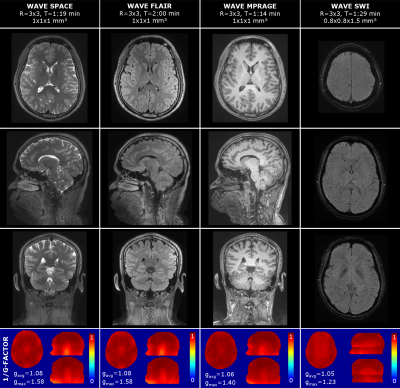 |
 Highly-accelerated volumetric brain protocol using optimized Wave-CAIPI encoding Highly-accelerated volumetric brain protocol using optimized Wave-CAIPI encoding
Daniel Polak, Stephen Cauley, Susie Huang, Maria Longo, Berkin Bilgic, Esther Raithel, Lawrence Wald, Kawin Setsompop
We introduce an optimized six-minute high-resolution whole-brain protocol of 3D, mainly isotropic acquisitions for T2w SPACE, FLAIR (3D), T1w MPRAGE and T2*w SWI; all acquired at 9-fold acceleration using Wave-CAIPI encoding. Design strategies were developed to optimize wave-encoding parameter selection, coil sensitivity computation, and data-driven automated gradient trajectory error estimation. We validated our exam on five volunteers on a 3T MRI scanner and achieved good SNR with negligible g-factor noise and good image contrast despite the 9-fold acceleration. Our fast high-resolution neurological exam should benefit several clinical and research applications and help mitigate patient compliance issues and motion artifacts.
|
17:15
 |
0938.
 |
 GRAPPA Reconstructed 3D Wave-CAIPI TSE at 7 Tesla GRAPPA Reconstructed 3D Wave-CAIPI TSE at 7 Tesla
Jolanda Schwarz, Eberhard Pracht, Tony Stoecker
In this work, wave-CAIPI sampling is incorporated in a 3D variable flip angle turbo spin echo (TSE) sequence optimized for ultra high field applications. The acquired wave-CAIPI data are reconstructed with a GRAPPA-based wave-CAIPI reconstruction algorithm using multiple reconstruction kernels. Highly accelerated wave-CAIPI TSE images with 1 mm3 resolution and whole brain coverage are acquired at a 7 Tesla scanner. A clear SNR improvement compared to Cartesian CAIPIRINHA is shown.
|
17:27
|
0939.
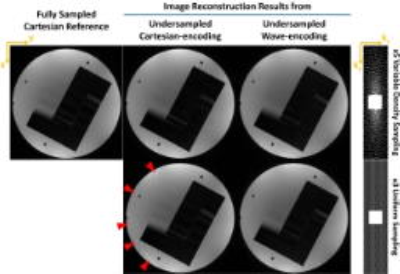 |
 Self-calibrating Wave-encoded 3D Turbo Spin Echo Imaging using Subspace Model based Autofocus Self-calibrating Wave-encoded 3D Turbo Spin Echo Imaging using Subspace Model based Autofocus
Zechen Zhou, Chun Yuan, Peter Börnert
Wave-encoding techniques can better utilize the three-dimensional (3D) encoding power of parallel imaging (PI) during acquisition and image reconstruction, but proper calibration of wave point spread function (PSF) and coil sensitivities are required. In this study, a self-calibrating wave PSF and PI kernel approach from subsampled wave-encoded k-space is proposed using subspace model based autofocus estimation. Its performance is evaluated for 3D wave encoded turbo spin echo (TSE) imaging. The preliminary results on phantom has demonstrated the calibration accuracy of self-calibrated wave PSF and improved PI performance in comparison to Cartesian based PI for 3D TSE imaging.
|
17:39
|
0940.
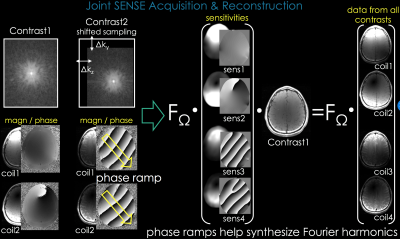 |
 Joint SENSE Reconstruction for Faster Multi-Contrast Wave Encoding Joint SENSE Reconstruction for Faster Multi-Contrast Wave Encoding
Berkin Bilgic, Stephen Cauley, Lawrence Wald, Kawin Setsompop
We introduce Joint SENSE acquisition/reconstruction to provide higher acceleration in multi-contrast acquisitions with improved image quality. We employ a complementary sampling strategy by shifting the k-space sampling patterns across the contrasts, which induces phase ramps in image space. By harnessing these ramps as additional coil sensitivity variations, we improve reconstruction error and g-factor performance by >2x compared to standard SENSE reconstruction. Further, we combine Joint SENSE with Wave encoding to exploit 4-dimensional sensitivity encoding, 3D across space + 1D across contrasts, to provide rapid multi-contrast acquisition with high quality.
|
17:51
|
0941.
 |
 Trajectory correction for a 3D-Ultrashort Echo Time (UTE) sequence using the gradient system transfer function Trajectory correction for a 3D-Ultrashort Echo Time (UTE) sequence using the gradient system transfer function
Manuel Stich, Lenon Mendes Pereira , Tobias Wech, Andreas Weng, Ralf Ringler, Thorsten Bley, Herbert Köstler
3D-Ultrashort Echo Time (UTE) sequences with 3D-kossh ball trajectory suffer from k-space trajectory deviations and ghosting artifacts due to hardware imperfections. The gradient system transfer function (GSTF), completely characterizes the gradient system as a linear and time-invariant (LTI) system. In this study, the GSTF was measured only using standard scanner hardware and was used to correct deviated trajectories in image reconstruction. This results in diminished ghosting artifacts and improve image quality.
|
18:03
|
0942.
 |
Cross Term and Higher Order Gradient Impulse Response Function Characterization using a Phantom-based Measurement
Video Permission Withheld
Jürgen Rahmer, Peter Mazurkewitz, Peter Börnert, Tim Nielsen
Characterization of the 3D field response of an MRI gradient system is important for proper system calibration. A powerful approach to 3D characterization is the acquisition of the gradient impulse response function (GIRF) using a set of distributed MRI probes. An alternative approach is the phantom-based measurement of the GIRF using a thin slice method. However, this method currently only delivers 0th order information (ΔB0) and 1st order direct terms (Gxx, Gyy, Gzz), but no cross terms (e.g. Gxy) or higher order information. We present an extension of the thin slice method by adding phase encoding for characterization of 1st order cross terms as well as higher order spatial components. Experimental results on the respective gradient modulation transfer functions (GMTFs) of a clinical system are presented.
|
|













